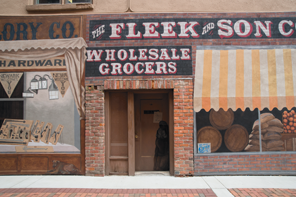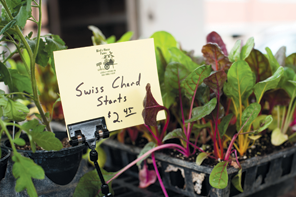Market Days
As we sit in downtown Newark’s stunningly renovated 19th century Pennsylvania Railway Station, Jazz Glastra, the executive director of Canal Market District, glances out the window at a stretch of sidewalk leading to a series of recently crafted open-air market pavilions one block away.
“People have really embraced the market,” Jazz says in reference to Canal Market District’s farm and craft markets held seasonally in the pavilions. “People tell me all the time that this is one of the best things to ever happen to their town.”
Centered on the city’s old canal, where boats once brought goods to market near the thriving train station and in view of the city’s bustling Courthouse Square, Canal Market District prides itself in being “rooted in the county’s history, culture and local bounty.” As Jazz notes, some citizens would argue that the development of the Canal Market District is the crown jewel in downtown Newark’s ongoing renaissance.
A nonprofit, the organization that oversees Canal Market District seeks to improve local food access in Licking County to grow healthy people, neighborhoods and economies. The organization connects the region’s farmers and entrepreneurs to a range of buyers through its market series and food hub, and has been welcomed by record numbers of Licking County residents eager to support growers, artisans and entrepreneurs in their community.
The Foundation
The Newark-based Thomas J. Evans Foundation invested $5 million into the renovation of Canal Market District, a dream of J. Gilbert (Gib) Reese, one of the Foundation’s founding trustees.
“Mr. Reese had a vision of bringing back a marketplace here in downtown Newark,” says Jennifer Roberts, administrative director of the Foundation.
For a number of years, Gib purchased property between South Park Place and Walnut Street, the land mass that now comprises Canal Market District. He approached public and private partners, advocating for a rejuvenated center of commerce in downtown Newark.
“This was 30 years in the making,” Jennifer says. “The vision came to fruition as a direct result of extraordinary partnerships between many groups in the community.”
Art, Food & Fun
Today, Canal Market District’s market series, now in its third season, is bringing to life Gib Reese’s vision of a reinvigorated center of commerce in his hometown.
This year an average of 30 vendors are anticipated at most market events. These entrepreneurs sell locally raised or crafted produce, meat, eggs, dairy products, baked goods and confections, sauces and seasonings, beverages, flora and wellness products. Vendors who specialize in locally made crafts are peppered in each week at the Tuesday farmers markets, and as a showcase at their own series of art markets.
“The Friday market tends to be like a date night,” says Carie Starr of Cherokee Valley Bison Ranch, a vendor. “There’s music and food trucks. People turn out not just for the farmers market but for the community.”
Lyle Linerode of Lona Belle’s Home Baked Goods has been a vendor at the Friday farmers market since its first season in 2016 and reports that the market has been a tremendous boost for his business. “I’m at three markets in the area each week. The Canal Market quickly became my best market,” he says.
Serving Food Deserts
Canal Market District also aims to support Newark’s hungriest citizens. The nonprofit was founded with the goal of improving the community’s access to healthy and fresh local food. Jazz and her team conduct a significant amount of outreach to Licking County’s low-income population to make them aware of the Canal Market District’s farm market series. In particular, they target the neighborhood of South Newark, a food desert within walking distance, located on the opposite side of the train tracks from the renovated railway station.
“We ensure that our low-income neighbors feel welcome at the market and that they have the ability to participate,” Jazz says.
Vendors accept payment through a number of government-funded nutrition programs, such as Supplemental Nutrition Assistance Program (SNAP) benefits and Women Infant Children (WIC) coupons. During the 2018 season, each market day SNAP-eligible shoppers will receive a $20 match for the purchase of fresh fruits and vegetables through the Produce Perks program.
Through funding from the Licking County Health Department, Canal Market District has also sent postcards advertising the Produce Perks match to SNAP-eligible households in Newark and Heath. They also received funding from Newark’s Department of Development to hire a seasonal food access assistant to conduct outreach to benefits-eligible community members.
According to Jazz, this work has paid off. “We have a couple of vendors who have said that 25% of their weekly sales come from SNAP.”
How Food Hubs Help
Another pillar of the organization’s operation is its Food Enterprise Hub, which connects Licking County growers with institutional purchasers, such as restaurants, hospitals and schools, to encourage economic development that is centered on local, reliable and high quality food supply chains.
Currently in pilot mode for the 2018 growing season, the Hub is partnering with eight local farms and four institutional purchasers to move produce through the region’s food system.
Farmers deliver product to the Hub, located at a kitchen facility shared by The Ohio State University Newark and Central Ohio Technical College (COTC).
“The kitchen is a teaching facility for COTC’s Culinary Science program but they are not there every day of the week or on evenings or weekends,” Jazz explains. “They have equipment and space, like coolers, that are underutilized and which we are able to access through our partnership.”
The Hub cleans, processes and distributes the produce to institutional buyers. “A lot of what we do focuses on simply aggregating and getting food back out the door. But we are also doing processing, which is somewhat unique for a food hub,” Jazz says.
Processing is one of the biggest hurdles in bridging the gap between producers and institutions. Kitchens often need food that is prepped for consumption or cooking, such as tomatoes diced, bagged and ready for use after opening.
The Food Enterprise Hub has the potential to transform the region’s local food economy by helping producers expand their operations through the cultivation of a consistent base of buyers of significant scale.
“Farm markets are critical,” Jazz says. “But farmers also need better access to wholesale markets to sell at scale. Through the Food Enterprise Hub we can help both farmers and buyers while growing our regional economy.”
Canal Market District offers a farmers market on Tuesdays (4–7pm, June to September) and Fridays (4–7pm, May to October); several art and craft markets each year and special events such as a Christmas market. Visit canalmarketdistrict.org to learn more or follow on Facebook and Instagram @canalmarketdistrict.






